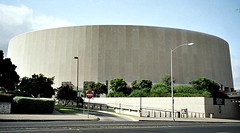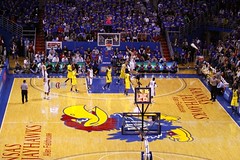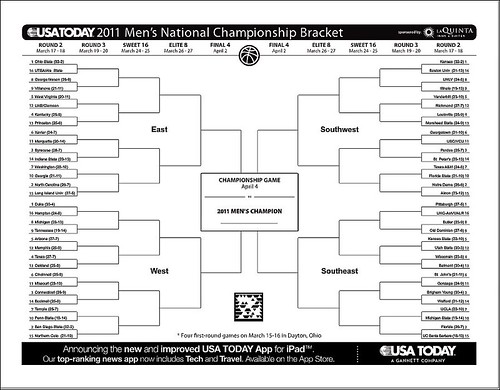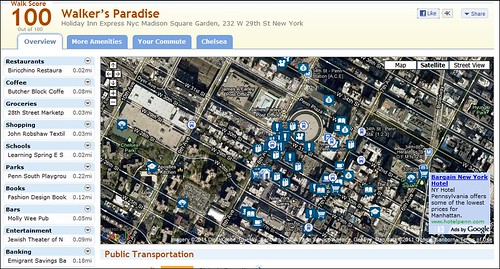March Madness for urbanists!

Posted March 14, 2011 at 1:26PM
It’s that time of year again. If you are a college hoops fanatic like I am, this is an amazing time. Last night, 68 teams were selected to compete in this year’s NCAA men’s Division I basketball tournament, which will crown a national champion on April 4. The field for the women’s D1 tournament will be announced tonight.
But the men’s field is the one that turns offices into a frenzy with, ahem, just-for-fun office pools. I’ve won ours twice, most recently a half-decade or so ago. But it was pure luck; a little knowledge is a dangerous thing. One might as well throw darts at a bracket and do just as well, most years.
Or - and now we arrive at the subject of this post - one could pick winners on the basis of smart growth and urbanist criteria. What if the teams whose home gyms had the highest Walk Scores, or the lowest carbon footprint for transportation, were the ones to advance? Don’t deny it: you’ve been wondering the exact same thing.
Well, wonder no more, because this blog will provide the answers. I have taken the top eight teams in each region and obtained a Walk Score for the location in which each plays its home games. Walk Score, as most of you know, is a measure of neighborhood completeness and location convenience: how many shops, services and amenities can one reach within walking distance from a given address?
The Walk Scores for the top 32 seeds bode well for the Red Storm of St. John’s, which plays at amenity-rich Madison Square Garden (Walk Score a perfect 100: see above), and also for my Georgetown Hoyas (DC’s Verizon Center, Walk Score 98) and the Cardinals of the University of Louisville (also a 98, for the ridiculously named KFC Yum! Center). All play in the Big East conference, without question this year’s most competitive. Walk Score also suggests good things for the Kentucky Wildcats, whose Rupp Arena scores 95. But the measure does not favor four-time national champion Duke (Cameron Indoor Stadium, the best place to watch basketball in the country, scores a paltry 23) or Kansas State and its hyper-intense coach, Frank Martin (Bramlage Coliseum gets only a 35).
I then ranked the teams from 1 to 32, based on their Walk Scores.
 But I didn’t stop there: Using the Abogo calculator from the Center for Neighborhood Technology, I then obtained a measure of the average carbon emissions from transportation per household located near for the teams’ home courts. Generally speaking, the better the location from a smart growth perspective, the lower the average emissions, because of reduced driving. Carbon emissions will tend to be lower where there is not just good walkability and neighborhood completeness, but also excellent regional accessibility, shortening car trips.
But I didn’t stop there: Using the Abogo calculator from the Center for Neighborhood Technology, I then obtained a measure of the average carbon emissions from transportation per household located near for the teams’ home courts. Generally speaking, the better the location from a smart growth perspective, the lower the average emissions, because of reduced driving. Carbon emissions will tend to be lower where there is not just good walkability and neighborhood completeness, but also excellent regional accessibility, shortening car trips.
The same three teams that came out on top of the Walk Score competition did well on this rating, too (St. John’s - 0.21 metric tons of carbon emissions per month per household, on average; Georgetown - 0.23 MT/mo; Louisville - 0.22 MT/mo), but so did the Badgers of Wisconsin (0.22 MT/mo) and even the University of Texas Longhorns (0.27 MT/mo), but UT still plays in the ugliest building of them all (photo below). But the number one ranking on this scale goes to UCLA, whose Westwood location in Los Angeles (Pauley Pavilion: 0.19 MT/mo) is not only one of the city’s most walkable but also well located relative to downtown LA and the rest of the region. The Wisconsin Badgers also score very well (0.22 MT/mo) on carbon emissions.
The big loser in the carbon-emissions ranking was George Mason, located in Fairfax, Virginia, where households emit a shocking 0.88 MT/mo, four times as much as the lowest emitters.  Other losers in the carbon-emissions scores were Connecticut (0.68MT/mo), Notre Dame (0.67MT/mo), and UT’s in-state rival Texas A&M (0.64MT/mo).
Other losers in the carbon-emissions scores were Connecticut (0.68MT/mo), Notre Dame (0.67MT/mo), and UT’s in-state rival Texas A&M (0.64MT/mo).
I ranked the 32 schools on neighborhood carbon emissions, and then averaged the Walk Score and Abogo rankings to determine my final picks. In the case of a few identical scores, I broke the ties by giving the higher spot to the team ranked higher in this week's Associated Press basketball poll.
My choices are set out below. Think of it this way: you’re not going to win your pool anyway, so you might was well be environmentally correct:
- St. John’s
- Louisville
- Georgetown
- Wisconsin
- UCLA
- Temple
- Vanderbilt
- Pittsburgh
- Texas
- Kentucky
- Syracuse
- Brigham Young
- San Diego State
- Arizona
- UNLV
- Xavier
- Notre Dame
- Purdue
- George Mason
- Ohio State
- Cincinnati
- Florida
- North Carolina
- Michigan
- Kansas
- Butler
- Connecticut
- West Virginia
- Kansas State
- Washington
- Texas A&M
- Duke
So: out of the top eight seeds in the East region, Kentucky, Syracuse, UNC and George Mason (saved by a good Walk Score) advance to the Sweet Sixteen and the regional championship round in Newark. Kentucky tops George Mason, and Syracuse beats UNC; then Kentucky edges Syracuse to win the region and advance to the urbanist Final Four. In the Southeast, St. John’s, Wisconsin, UCLA and Pittsburgh advance to the Sweet Sixteen and the regional championship round in New Orleans. Wisconsin tops Pitt, and St. John’s beats UCLA; then top-ranked St. John’s wins the region over Wisconsin and advances to the Final Four.
In the Southwest, Louisville, Georgetown, UNLV and Notre Dame advance to the Sweet Sixteen and the regional championship round in San Antonio.  Louisville tops UNLV, and my Georgetown Hoyas (with Chris Wright back from injury at point guard) beat Notre Dame; then Louisville edges the Hoyas and advances to the Final Four. In the West, Michigan, Temple, Cincinnati and Texas advance to the Sweet Sixteen and the regional championship round in Anaheim. Somehow Texas then tops Michigan, and Temple beats Cincinnati; then Temple restores urbanist order by winning the region over Texas and advances to the Final Four.
Louisville tops UNLV, and my Georgetown Hoyas (with Chris Wright back from injury at point guard) beat Notre Dame; then Louisville edges the Hoyas and advances to the Final Four. In the West, Michigan, Temple, Cincinnati and Texas advance to the Sweet Sixteen and the regional championship round in Anaheim. Somehow Texas then tops Michigan, and Temple beats Cincinnati; then Temple restores urbanist order by winning the region over Texas and advances to the Final Four.
In the Final Four in Houston, Kentucky beats Temple and St. John’s beats Louisville in a battle of urbanist titans to advance to the championship game. Your national champion, based on smart growth and urbanist criteria, will be the mighty Red Storm of St. John’s. You heard it here first.
But what about the teams seeded nine through sixteen in each region, which I didn't research, you may wonder. Don’t worry about it; nobody is beating St. John’s when it comes to a highly walkable, low-carbon location.
Trivia: The worst named gyms have to be the aforementioned KFC Yum! Center and the University of Cincinnati’s puzzling Fifth Third Center. Too bad Providence, with its Dunkin’ Donuts Center, didn’t make the tournament this year. The best named have to be Phog Allen Fieldhouse, which hosts the University of Kansas but has a ridiculous painted chicken (OK, Jayhawk, photo above) on its gym floor, and Kentucky’s Adolph Rupp Arena. The scariest gym floor has to be Vanderbilt's, where it is actually raised above the team benches and "courtside" seats, just waiting for a player to chase a ball out of bounds and fall off.
St. John's is not just an urbanists' pick, BTW. They beat both of the teams I root for this season, including the one that's now a number one seed. I've already heard one pundit pick them for the Final Four. In addition to rooting for the Hoyas and Blue Devils as per usual, a piece of my heart is also with the Bulldogs of UNC-Asheville, from my home town. Tough draw, though; even if they best Arkansas-Little Rock in the opener, they will draw Pitt in their second game.
Move your cursor over the images for credit information.

